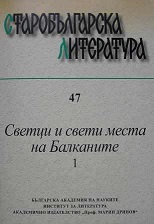Ранните (пред-Евтимиеви) жития и служби за св. Петка Търновска в българската и сръбската книжовна традиция от ХІІІ–ХV в.
The Earlier (Pre-Euthymian) Vitae and Offices of St. Paraskeve of Tărnovo in Bulgarian and Serbian Literary Tradition from the Thirteenth to the Fifte
Author(s): Radoslava StankovaSubject(s): Language studies
Published by: Институт за литература - БАН
Summary/Abstract: The paper offers a comprehensive picture of the earliest calendar commemo-rations and literary sources which demonstrate the establishment of cult of St. Paraskeve of Tărnovo (Paraskeve of Epibatai) among Bulgarians and Serbs from the 13th century on. The saint is first mentioned in the calendars of Gospels and Apostolos Synaxaria, Psalters and in a Prayer-book. The paper also discusses the versions of the (short) Prolog vitae of St. Paraskeve and gives an account of their copies in Prologs and Menaia from 14th and 15th centuries. Further, there is also a troparion commemorating the St. Paraskeve in the Prolog. In the Versified Prolog, the short vita is copied without the Prolog verses, which, however, could be found in the Menaion copies of the saint’s Office. The paper offers a detailed scrutiny of texts from the 13th to the 15th centuries which present the three recensions of the Saint’s Office. The Serbian copies are prevailing, especially in the manuscripts associated with the Hilandar monastery at Mount Athos. The last part of the paper focuses on the represantional devices (tropes) used in the texts on St. Paraskeve. It demonstrates the similarities in the poetics and the differences in the stylistics of the two genres – namely, the short vita and the office. The author suggests that the comparative study of the representation of the saint in the hagiographic and hymnographic works could answer important questions, such as: How have the liturgical texts been changed, revised and reconsidered through the centuries within the ritual to acquire a new meaning?; Why and at what point were the new texts created?
Journal: Старобългарска литература
- Issue Year: 2013
- Issue No: 47
- Page Range: 222-239
- Page Count: 18
- Language: Bulgarian
- Content File-PDF

